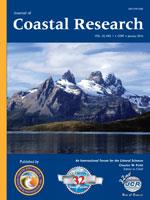Ramsdale, T.M. and Fairweather, P.G., 2016. A calibration equation for combining dry-sieving and laser-diffraction techniques for assessing grain-size distributions of beach sands.
Using laser diffraction to determine sediment grain-size distributions is faster than sieving methods; however, the results of these analytical methods can often differ. Samples are generally only analysed using one method, so the need to convert results, such as for comparison with published values or earlier data collected using different analytical techniques, may arise. To determine a calibration equation for comparing results obtained by laser diffraction to those from test sieves, natural beach-sand samples were processed by both methods and results for mean grain size, sorting, skewness, and kurtosis were compared. There was a strong, linear relationship between methods for mean grain-size values, and calibration between the two methods thus was found to be possible by using the equation: mean grain size (laser diffraction) = 1.441 (test-sieve grain size) − 16.524, in micrometres. Calibration was also possible between values derived for the sorting coefficient: sorting (laser diffraction) = 0.654 (test-sieve sorting) 0.496. Laser diffraction–derived values were coarser, with wider grain-size distributions (indicating poorer sorting), but distributions were more symmetrical and more peaked when compared to sieving-derived values. Values for sorting coefficient, skew, and kurtosis may be affected by smoothing calculations within the laser-diffraction particle-sizing software. For these processed beach-sand samples, laser diffraction offers a faster method for grain sizing, with the tight mathematical relationship of mean grain-size and sorting values obtained between the two methods tested allowing comparison, if needed, of laser-diffraction values to sieving-derived values. This finding allows the comparison of data across studies, especially to earlier work that did not use laser-diffraction technology.





